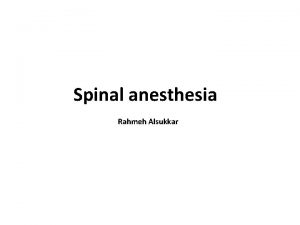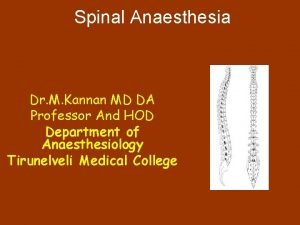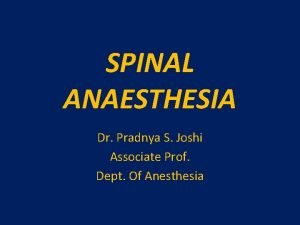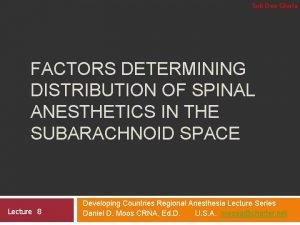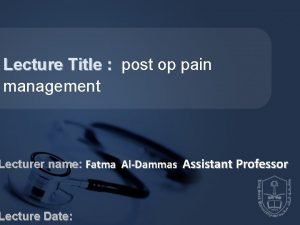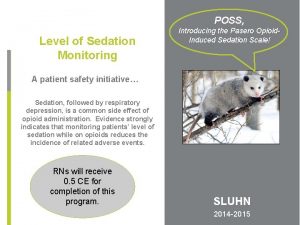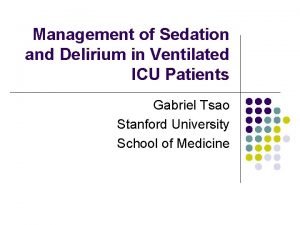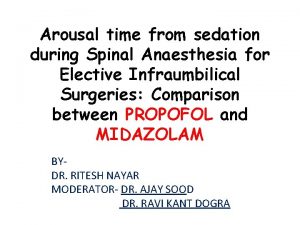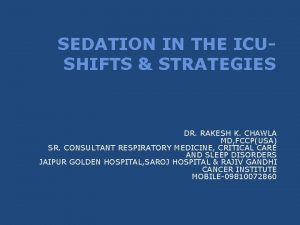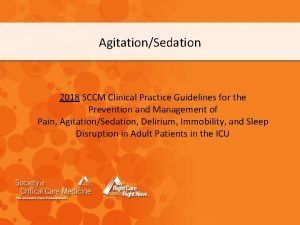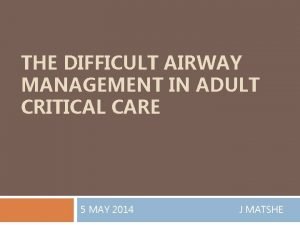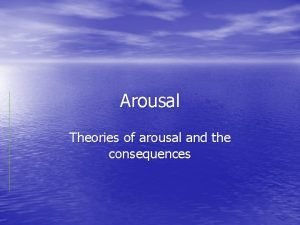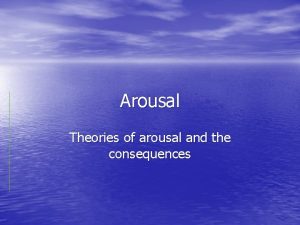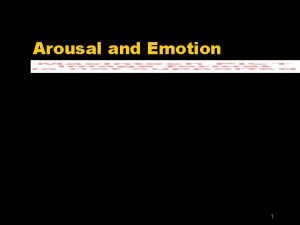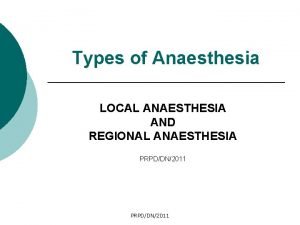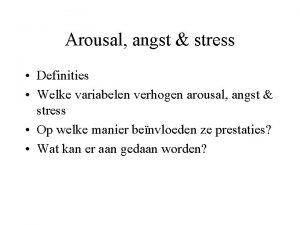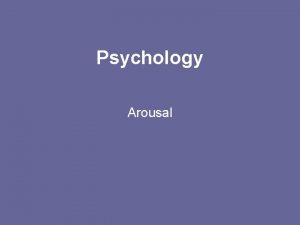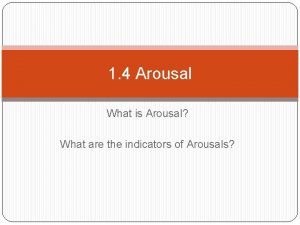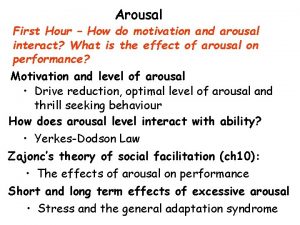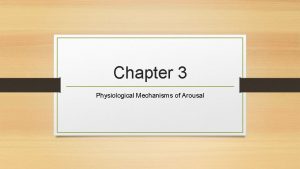Arousal time from sedation during Spinal Anaesthesia for


















- Slides: 18

Arousal time from sedation during Spinal Anaesthesia for Elective Infraumbilical Surgeries: Comparison between PROPOFOL and MIDAZOLAM BY- DR. RITESH NAYAR MODERATOR- DR. AJAY SOOD DR. RAVI KANT DOGRA

BACKGROUND AIM • This study was designed primarily to compare arousal time from sedation using propofol with that of midazolam during spinal anaesthesia for infraumbilical surgeries. • Depth of sedation was monitored continuously with bispectral index (BIS) monitor. • The correlation between the BIS score and observer's assessment of awareness/sedation (OAA/S) score during recovery from sedation was also studied.

INTRODUCTION SEDATION 1. Stress factors in operation room and block level mismatch with surgical area may contribute to discomfort, anxiety and restlessness in patients under spinal anaesthesia. [1] Sedation is a valuable tool to provide general comfort for the patient. 2. To provide amnesia of surgical events. 3. To increase patient acceptance to regional anaesthesia.

OVERSEDATION HAZARDS OF OVER-SEDATION It jeopardizes the patient safety. 1. It increases the chances of pulmonary aspiration of gastric contents. 2. Oversedation may be associated with untoward effects of respiratory and cardiovascular depression. 3. Ultimately resulting in higher chances of airway instrumentation and hypotension leading to a prolonged hospital stay.

MONITORING DEPTH OF SEDATION • It is required to prevent both under as well as over-sedation • It was done by 2 methods 1. BISPECTRAL INDEX 2. OBSERVER’S ASSESSMENT OF SEDATION/ AWARENESS SCORE

BISPECTRAL INDEX • Used to monitor Depth of anaesthesia. • A novel measure of the level of consciousness by the algorithmic analysis of a patient’s EEG during anaesthesia. • BIS is an EEG derived multivariant scale that correlates with the metabolic ratio of glucose. • It does tell about the cause of reduced consciousness. • BIS provides a single number ranging from 0 to 100. • 0= EEG Silence • 100= Fully awake • BIS Value of 40 -60 indicates an appropriate level for general anaesthesia.

METHODS • TYPE OF STUDY- RANDOMISED CONTROL TRIAL registered with Clinical Trial Registry of India • SAMPLE SIZE- Total 110 subjects in 2 groups of 55 each were taken after informed consent. • SUBJECTS- Patients of either sex with age between 18 and 60 years complying with American Society of Anesthesiologists (ASA) physical status I and II criteria, posted for elective infraumbilical operations (surgical, gynaecological, or orthopaedic) of approximate 90 min duration were selected.

• EXCLUSION CRITERIA-Patients not willing to accept spinal anaesthesia, those not willing to receive sedation during surgery, or having any contraindication to spinal anaesthesia were excluded. • PREMEDICATION 1. Ringer lactate@ 15 ml/kg over 30 mins. 2. inj. Ranitidine 50 mg i. v. 3. inj. Ondansetron 4 mg i. v. 4. inj. Tramadol 50 mg i. v. slowly

ANAESTHESIA TECHNIQUE-Spinal anaesthesia was given in the left lateral decubitus position with 2. 5 -3. 0 ml of 0. 5% bupivacaine heavy using Quincke needle (26 G) at the L 3 -L 4 interspinous space. After a sensory block to T 6, sedation was initiated as appropriate for the group of study and the surgery was started. MONITORING- BIS monitor, ECG, non invasive Blood pressure, pulse oximetry.

• Patients in the Group P received bolus of propofol (1 mg/kg), followed by infusion at 3 mg/kg/h. • Patients in Group M received bolus of midazolam (0. 05 mg/kg), followed by infusion at 0. 06 mg/kg/h and titration until BIS score 70 or OAA/S Score of 3 was achieved and maintained between 65 and 70. • OAA/S score was noted at BIS 70 and again at BIS 90 during recovery. The time to achieve OAA/S score 5 was noted. • Data were charted on the Excel Workbook and analyzed using Statistical Package for the Social Sciences (SPSS) for Windows

AROUSAL TIME • The arousal of the patient was defined as achieving a BIS score of 90. • AROUSAL TIME was taken as the time from the stoppage of infusion of the study drug till a BIS Score of 90 is achieved.

RESULT • The study spanned from July 2011 to April 2012. • Total 7 patients had to be converted to general anaesthesia thereby making the effective sample size 103, (Group P [n = 52], Group M [n = 51]) • . The Groups P and M were found to be comparable in respect of age, weight, height, sex distribution, the ASA physical status and duration of surgery

• Arousal time from sedation was found lower for Group P compared to Group M (7. 54 ± 3. 70 vs. 15. 54 ± 6. 93 min, respectively, P = 0. 000). • The time taken to reach OAA/S score 5 was also found to be lower for Group P than Group M (6. 81 ± 2. 54 min vs. 13. 51 ± 6. 24 min, respectively, P = 0. 000).

Scatter diagram showing the relation between the arousal time from sedation (bispectral index 90) and time taken to reach an observer's assessment of awareness/sedation score of 5 in both the study groups.

• In addition, the MAP and the HR were lower in the Group P than in Group M, but the intragroup MAP and HR in both the groups were stable throughout. The MAP and HR showed a slight rise nearing the end of surgery and recovery in both groups. In both groups, the Sp. O 2 values were distributed in an almost linear fashion with no wide variations.

DISCUSSION • The reversibility of sedation is more rapid with cessation of infusion of propofol. CAUSES • This may be due to the higher clearance rate of propofol (around 30 ml/kg/min) with respect to that of midazolam (6 -11 ml/kg/min), which is claimed to be a result of extrahepatic metabolism of propofol. • Furthermore, the concentration of propofol in the brain falls rapidly owing to its redistribution, leading to quick recovery. In comparison, the concentration of midazolam in the brain tissue has an initial phase of rapid decrease due to redistribution, which is followed by a slower phase resulting from the metabolism of the drug. Midazolam on metabolism in the liver produces an active metabolite, 1 -hydroxy midazolam, which may be responsible for its delayed offset of action.

CONCLUSION A shorter arousal time from sedation during spinal anaesthesia can be achieved using propofol compared with midazolam, while depth of sedation was monitored with BIS monitor and OAA/S score. Both objective and clinical scoring correlate strongly during recovery from sedation.

THANK YOU
 Taylor approach epidural
Taylor approach epidural Structures pierced during spinal anaesthesia
Structures pierced during spinal anaesthesia Spinal block location
Spinal block location Spinal anaesthesia position
Spinal anaesthesia position Contraindications of spinal anaesthesia
Contraindications of spinal anaesthesia Epidural space
Epidural space On occasion our trusty truck
On occasion our trusty truck Epineurium
Epineurium Innervations of the brachial and lumbar enlargements
Innervations of the brachial and lumbar enlargements Spinal cord and spinal nerves exercise 15
Spinal cord and spinal nerves exercise 15 Poss level
Poss level Richmond agitation sedation scale
Richmond agitation sedation scale Richmond agitation sedation scale
Richmond agitation sedation scale Over-sedation
Over-sedation Rikers sedation scale
Rikers sedation scale Sédation
Sédation Sccm sedation guidelines
Sccm sedation guidelines Difficult airway algorithm
Difficult airway algorithm Chin lift jaw thrust
Chin lift jaw thrust
